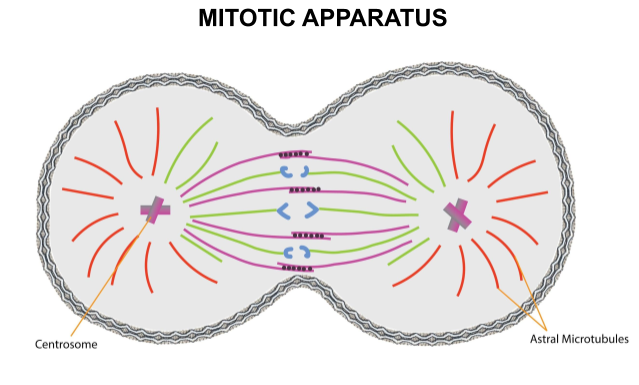
Astral rays arise from
(a) Centrosomes
(b) Cytoplasm
(c) Chromatid
(d) None of the above
Answer
578.1k+ views
Hint: Astral rays arise from a non-membranous organelle found in animal cells which helps in cell division. It contains two cylindrical structures called ‘centrioles.’ Both the centrioles are arranged perpendicular to each other within the cell and each one has an organisation like a cartwheel.
Complete answer:
Astral rays arise from centrosomes. Let’s look into the cell division in detail to understand better.
- Cell division is considered a very important process in all living organisms.
- The ‘cell cycle’ is the sequence of events by which a cell duplicates its genome, then forms the other constituents of the cell and ultimately divides into two daughter cells.
The cell cycle is divided into two phases:
M phase (Mitosis phase): represents the phase when the actual cell division or mitosis occurs.
Interphase:
- It represents the phase between two consecutive M phases.
- One of the important events that occur in this phase is the duplication of the centrosome.
M Phase:
- The mitotic phase is also called the equational division.
- For convenience, mitosis has been divided into four stages of nuclear division or karyokinesis. They are Prophase, Metaphase, Anaphase, and Telophase.
Let's learn briefly about the events characteristic of prophase.
- The centrosome which had duplicated in the interphase begins to move towards the opposite poles of the cell.
- Long microtubules subsequently radiate out of each centrosome. These radiating tubules are called ‘asters.’
- The two asters at the opposite poles along with the spindle fibers together form mitotic apparatus.

So, the correct answer is ‘Centrosomes.’
Note: The division of cytoplasm usually occurs at the end of the M phase. This phenomenon is known as ‘cytokinesis.’ Duplication of centrioles occurs within the cytoplasm.
- During prophase, two chromatids attached at the centromere together form a chromosome.
-In anaphase, two daughter chromatids are formed by the splitting of each chromosome. These daughter chromatids are now referred to as daughter chromosomes for the future nucleus.
Complete answer:
Astral rays arise from centrosomes. Let’s look into the cell division in detail to understand better.
- Cell division is considered a very important process in all living organisms.
- The ‘cell cycle’ is the sequence of events by which a cell duplicates its genome, then forms the other constituents of the cell and ultimately divides into two daughter cells.
The cell cycle is divided into two phases:
M phase (Mitosis phase): represents the phase when the actual cell division or mitosis occurs.
Interphase:
- It represents the phase between two consecutive M phases.
- One of the important events that occur in this phase is the duplication of the centrosome.
M Phase:
- The mitotic phase is also called the equational division.
- For convenience, mitosis has been divided into four stages of nuclear division or karyokinesis. They are Prophase, Metaphase, Anaphase, and Telophase.
Let's learn briefly about the events characteristic of prophase.
- The centrosome which had duplicated in the interphase begins to move towards the opposite poles of the cell.
- Long microtubules subsequently radiate out of each centrosome. These radiating tubules are called ‘asters.’
- The two asters at the opposite poles along with the spindle fibers together form mitotic apparatus.

So, the correct answer is ‘Centrosomes.’
Note: The division of cytoplasm usually occurs at the end of the M phase. This phenomenon is known as ‘cytokinesis.’ Duplication of centrioles occurs within the cytoplasm.
- During prophase, two chromatids attached at the centromere together form a chromosome.
-In anaphase, two daughter chromatids are formed by the splitting of each chromosome. These daughter chromatids are now referred to as daughter chromosomes for the future nucleus.
Recently Updated Pages
Master Class 12 Economics: Engaging Questions & Answers for Success

Master Class 12 Maths: Engaging Questions & Answers for Success

Master Class 12 Biology: Engaging Questions & Answers for Success

Master Class 12 Physics: Engaging Questions & Answers for Success

Master Class 8 Maths: Engaging Questions & Answers for Success

Class 8 Question and Answer - Your Ultimate Solutions Guide

Trending doubts
What is meant by exothermic and endothermic reactions class 11 chemistry CBSE

10 examples of friction in our daily life

One Metric ton is equal to kg A 10000 B 1000 C 100 class 11 physics CBSE

1 Quintal is equal to a 110 kg b 10 kg c 100kg d 1000 class 11 physics CBSE

Difference Between Prokaryotic Cells and Eukaryotic Cells

What are Quantum numbers Explain the quantum number class 11 chemistry CBSE




